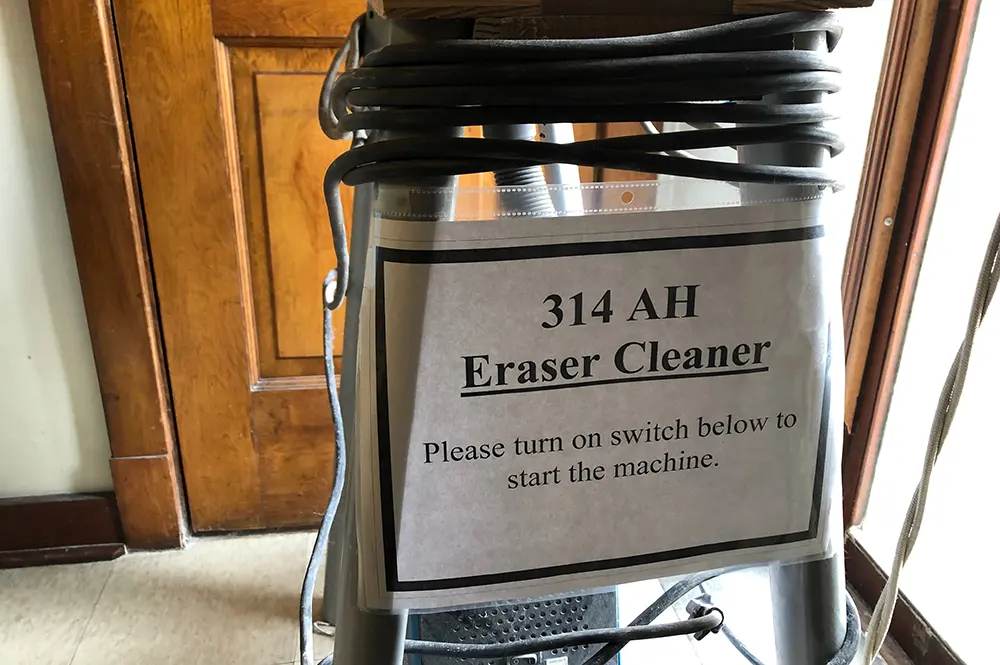

What do you get when you add mathematics and chalkboards? Grant Cole, a building service worker from Facilities & Services who worked in Altgeld Hall, can answer that question: Dust, and lots of it.
As a cleaner in one of the busiest buildings on campus—a mathematics building to boot—Cole knew how the learning process could be accompanied by clouds of dust as dense as the morning fog. The question was, what to do about it? Anybody who knows math professors knows how they love their chalkboards. But nobody seemed to have a good solution for the gritty side effects.
“Some of the staff and faculty were beating their chalk erasers against the wall,” Cole said. “They were beating them on the radiators on each side of the chalkboard, and even on the wall going to the elevator. And then I observed another professor, walking across in front of the stage, and he was holding two of the longer erasers together, rubbing them and beating them to get the chalk dust out.”
Toshua York, director of budget and resource planning in the Department of Mathematics, said the problem seemed hopeless.
“Some of the faculty were getting chalk dust everywhere,” York said. “It was creating a huge mess, but they would say, ‘We don’t know how else to clean them!’”
Cole did his best to combat the problem. At the request of faculty, he switched out erasers in the middle of the day and washed chalkboards between classes. But Cole was resourceful, and he brainstormed an easier solution.
“I thought about finding grating wire or chicken wire to hang on a cable so they could beat it on that, into a trash can,” Cole said, “but as I was looking around, I came across an old backpack vacuum that was collecting dust in one of the rooms of Altgeld and had a new idea.”

With some scrap metal, wood, and the help of his friend, Ralph Keil, Cole created a chalk vacuum at zero cost. It was a hit. A year later, Cole’s popular chalk vacuum sits in Altgeld Hall, where students and professors alike slide the erasers over the device and condemn all those dust particles to a proper holding place.
“A few professors told me that they think it’s wonderful, that they come and see it, and they think it’s pretty cool,” Cole said. “Altgeld is a math building, and math professors, they don’t do anything without a piece of chalk in their hand.”
Rinat Kedem, professor of mathematics, would agree. Kedem actually has her very own chalk vacuum in her office. It was a gift from colleagues from Osaka, Japan, where she lived and taught for years. That’s where she developed a respect for chalkboards and chalk; every classroom in Japan has a chalk vacuum, she said.
“They have the studies where if you take notes, it makes a difference because it allows you time to reflect on what you just wrote. Writing changes the way you think, and the writing medium changes the way you think. It’s very important for me,” Kedem said. “Mathematicians all over the world prefer blackboards.”
Kedem is enthusiastic about Cole’s solution to Altgeld’s dust problem.
“Every classroom with a blackboard should have a chalk vacuum,” Kedem said. “Chalk dust is a major irritant for mathematics professors in general and me in particular, and this little machine makes a big difference in my office.”
Cole’s supervisor, James Matthews, assistant superintendent of building services at Facilities & Services, is pleased with Cole’s initiative.
“Grant coming up with this idea shows how much he cares about what he does here at the university,” Matthews said. “We truly appreciate that quality in people.”


